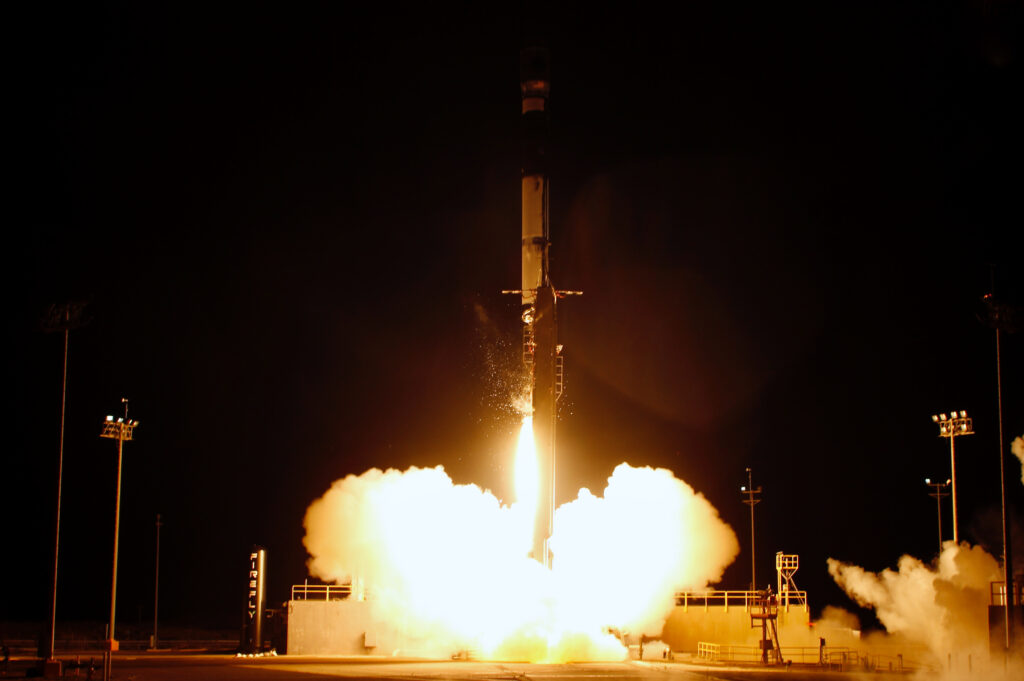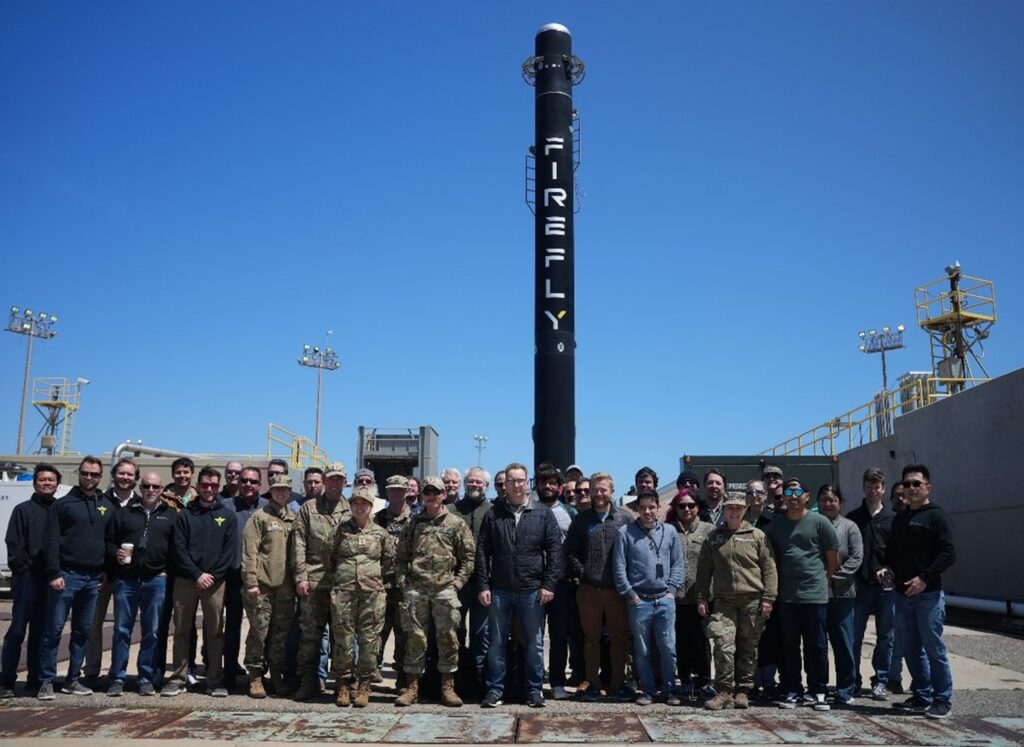Space News & Blog Articles
Rapid response Victus Nox launch success open new possibilities for Space Force, commercial space industry
 Proving a quick turnaround capability for the U.S. Space Force’s Space System Command’s Space Safari Program Office, the Victus Nox mission launches using a Firefly Aerospace Alpha rocket. Image: Firefly Aerospace
Proving a quick turnaround capability for the U.S. Space Force’s Space System Command’s Space Safari Program Office, the Victus Nox mission launches using a Firefly Aerospace Alpha rocket. Image: Firefly Aerospace
Nearly two weeks after the successful launch of a payload for the U.S. Space Force’s Space System Command, leaders from the branch along with launch provider, Firefly Aerospace, and satellite manufacturer, Millennium Space Systems, touted the importance and details of the mission during a press briefing on Tuesday.
Lt. Col. MacKenzie Birchenough, the materiel leader for the SSC’s Space Safari Program Office (an acquisition program office supporting USSPACECOM), said the Victus Nox mission was an important step forward in establishing what they term “Tactically Responsive Space” (TacRS) missions.
“The overarching purpose of this mission was to demonstrate our ability to rapidly… deter and, if necessary, respond to adversary threats in the space domain,” Birchenough said.
The Sept. 14 launch of the Victus Nox spacecraft on a Firefly Alpha rocket was the company’s third launch to date and demonstrated a record turnaround time for a mission from end-to-end.
As images of Firefly’s Alpha rocket soaring through the night sky were captured across the southwest United States, a team of passionate Fireflies flawlessly executed a mission that has never been done before — launching after a 24-hour notice.
Here’s how the U.S. Space Force’s… pic.twitter.com/TcEjpHqYyi
— Firefly Aerospace (@Firefly_Space) September 15, 2023
After receiving the contract for the mission in 2022, both Firefly and Millennium entered into a six-month, so-called “hot standby” phase of the operation. Within those months, at any point, they could be given an alert that kicked off the 60-hour window during which the satellite would need to be delivered to Vandenberg Space Force Base (VSFB) to undergo final launch preparations.
Once on orbit, Millennium had a 48-hour goal to have the satellite in an operational state.
Millennium got the spacecraft to VSFB, tested it and mated it to the launch adapter in less than 58 hours, compared to the standard timeframe of weeks to months. They were able to do so by pulling one of their spacecraft buses from an existing production line that was eight months into the manufacturing process.
“Five plus years ago, Millennium didn’t have an active production line, but now we have several and really its because we’re focused on national security space, just like Firefly is,” said Jason Kim, the CEO of Millennium Space Systems, a subsidiary of Boeing. “There’s a lot of threats, adversary threats out there and we’re trying to get ahead of them.”
On the launch side, Firefly was able to get its Alpha rocket to the pad, complete all pre-launch requirements and fuel it within the first 24 hours and launch within the first window at 7:28 p.m. PDT (0228 p.m. UTC on Sept. 15).
Firefly CEO Bill Weber said having a rapid response-type of mentality is something that he wants the company to maintain moving forward.
“The entire team worked as a unified force. We set new standards, I think, that the rest of the industry is going to meet, and this will be the expected standard going forward,” Weber said. He later added that they would “not inject risk in order to meet a timeline.”
“We’re not looking for a trophy or a merit badge to be able to say that we got it done in 24 hours. We want mission success,” Weber said. “What we believe we just proved is that we can do things in parallel that used to be done in serial. We can get a lot more efficient about steps that we were never pushing for any kind of speed. That it is possible to do that without creating risk in the mission.”
Millennium space was also able to get the satellite in operation order in 37 hours, beating its 48-hour goal.
Benefits of speeding up
In discussing the Victus Nox mission on Tuesday, Lt. Col. Justin Beltz, the materiel leader and chief of the SSC Small Launch and Targets Division, said it was a concerted effort to pivot on their part and improve upon the previous 21-day launch record set on June 13, 2021, by the SSC’s TacRL-2 mission.
“Our respective government team had their day job at the different bases that they work and so, when we got called to alert status, everyone immediately picked up the phone and booked flights to Vandenberg Space Force Base,” Beltz said. “We transited out there and planned to stay for the duration of the mission. That was what was required to enable that kind of speed.”
Beltz and his colleagues said this demonstration is an important step on being able to stand up the full ability for TacRS missions starting in 2026, a goal that SSC leaders said was achievable.
“We set the bar really high with Victus Nox, so it’s going to be very difficult to top that, but we want to continue to push commercial industry as hard as we can because we know the threats are not going to slow down,” said Maj. Jason Altenhofen, the deputy branch chief of Space Safari. “We need to leverage the competition, the commercial base, as much as possible because we want to get faster and that goes for build to on-orbit ops.”
Going into this mission, Beltz said there were a suite of seven possible flight profiles that Firefly was ready to perform. He said the goal is to be able to establish more nimble rapid response capability, both in location as well as orbital destination. That includes, he said, continuing to work alongside other federal agencies for operations like this, such as the Federal Aviation Administration (FAA).
“As we head towards the future, we need to kind of tease apart the tension between speed and flexibility and get to the point where we’re hitting both in full,” Beltz said.
Firefly said for its part, it is looking towards increasing its launch capabilities by bringing Space Launch Complex 20 (SLC-20) at Cape Canaveral Space Force Station online. Weber said construction is ongoing.
“[Victus Nox] was flight three. We could probably fly up through flight eight out of Vandenberg. Somewhere in the six, seven, eight timeframe for Alpha flights, SLC-20 will come online and we’ll be able to fly East and West Coast missions,” Weber said. “We’re about a year, maybe a year-and-a-quarter calendar-wise away from that capability coming online there.”
Beltz said the actions that they’re taking now are a response from what he and others describe as increasing aggression in the space domain. He pointed to an incident in 2019 when Russian satellites “cozied right up to an important United States satellite,” noting that at the time, “the (response) playbook was very limited.”
“Those conversations have directly prompted our ability to do this kind of mission and so, that very much is the focus,” Beltz said. “I am sure that over the years and decades, this kind of mission will play out in a way that nobody is predicting today, but the important thing is that we’re addressing kind of a clear threat and making sure that the United States can respond.”
 Alpha launch provider, Firefly, and payload provider, Millennium, moved into the hot standby phase and wait for the VICTUS NOX callup. Image: Firefly Aerospace
Alpha launch provider, Firefly, and payload provider, Millennium, moved into the hot standby phase and wait for the VICTUS NOX callup. Image: Firefly Aerospace
Eyeing the future
Regarding funding, $30 million was requested for this TacRS program missions in each FY24 and FY25.
“I think we fully recognize that that’s not going to scale to a fully operational solution,” Altenhofen said. “These demonstrations are really about proving capabilities, proving that we can do it and then we’re working through the budget process to figure out what right size of funding is needed to make a truly operational, repeatable capability for the future.”
The contracts for launch providers and satellite manufacturers are open and officials described them as robust, but declined to specify which others competed.
“Launch providers view these responsive missions as a key part of the value proposition,” Beltz said. “The ability for these systems to focus on a timeline like this and execute to it, it’s pretty important and I think you’ve probably seen each company in that segment, kind of seek to specialize in some way.”
The next such demonstration TacRS mission is called “Victus Haze,” which represents a partnership between the Space Safari Program Office and the Defense Innovation Unit (DIU). It’s goal is to “focus on end-to-end execution using commercial capabilities.”
Birchenough said they are applying lessons learned from Victus Nox to Victus Haze.
“I think you could walk through every single phase and every single step of this and kind of refine those processes and that’s really what this mission was all about,” she said. “We certainly intend to roll as many of those lessons learned as we can into Victus Haze and our future efforts.”
Contracts for Victus Haze will be awarded in the Fall of 2023. A launch timeframe has not yet been announced.
When you subscribe to the SpaceZE News Feed, we will send you an e-mail when there are new updates on the site so you wouldn't miss them.

